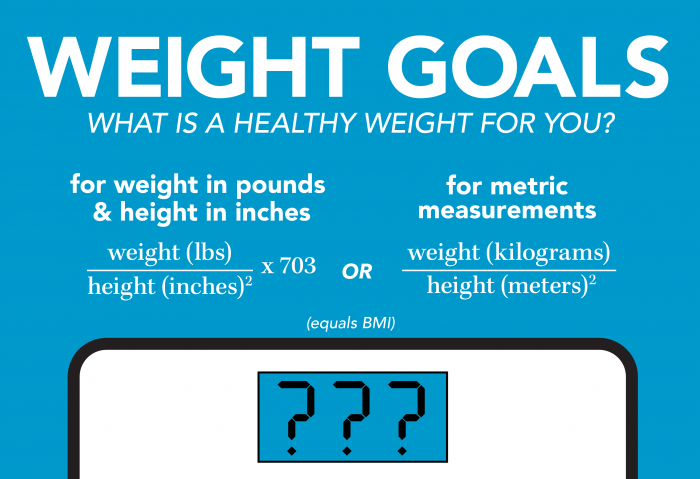Weight Goals: What Is a Healthy Weight for You?

Obtaining and maintaining a healthy weight is important for your physical and mental health; being overweight can lead to a number of health problems. The best and healthiest way to lose weight or to maintain a healthy weight is through good nutrition and adequate physical activity.
Diet

Although dieting and becoming healthier are growing trends, there is still a gap between what the average American eats and what is recommended. Many people strive to eat less saturated fat and dietary cholesterol, yet they often do not eat the recommended daily servings of fruits and vegetables. Eating fruits, vegetables, and other nutrient-dense foods can help you lose weight because these foods tend to be low in calories but filling, which means you consume fewer calories overall.
People often eat a lot of calories through snacking on foods like potato chips and cookies, which have no nutritional value and are therefore considered “empty” calories. So if you want to lose weight or maintain your weight, make sure to pay attention to what you munch on between meals. Eating smaller portions is another way to reduce your total caloric intake. When eating at home, try serving your food on a smaller plate. Typically, people eat whatever is on their plate, even if they are already full. So using a smaller plate may help you consume less. After finishing this smaller portion of food, sit for a few minutes and then decide if you're still hungry enough for a second helping.
Exercise
Physical activity also plays a major role in obtaining and maintaining a healthy weight. According to the Centers for Disease Control and Prevention, adults should fit in at least 2.5 hours of moderate-intensity aerobic activity every week. This goal is achievable when you consider that moderate-intensity exercise includes activities such as brisk walking. If 2.5 hours seems too big of a time commitment, you can substitute 1.5 hours of vigorous-intensity aerobic activity, such as jogging, running, and cycling. In addition to aerobic exercise, always include at least two muscle-strengthening sessions each week, making sure to work all major muscle groups.
BMI
Of the various ways to assess your weight and determine a healthy weight range, the easiest method is the body mass index (BMI) test. To figure out your BMI, plug your weight and your height into this equation:
You can also use an online BMI calculator to determine your BMI. Here's the rule of thumb for deciphering BMI scores (for individuals age 18 or older):- <18.5: underweight
- 18.5–24.9: normal weight
- 25–29.9: overweight
- 30+: obese
If you discover that you are in the overweight or the obese category, consult with your physician, who will be able to tell you if your extra weight is a health risk. Because BMI does not account for body composition, your physician may use further assessments, such as biomedical tests and a skin-fold test, to more accurately measure your body fat percentage. If the results indicate you would benefit from losing weight, then following the diet and exercise tips above will help you start down a healthier path.
References
Centers for Disease Control and Prevention. (2011, May 4). Healthy Weight—It's Not a Diet, It's a Lifestyle!
Centers for Disease Control and Prevention. (2011, December 1). How Much Physical Activity Do Adults Need?
Written by Jessica Shepherd and Holly Michaels, MS, RD, CD



Leave a comment